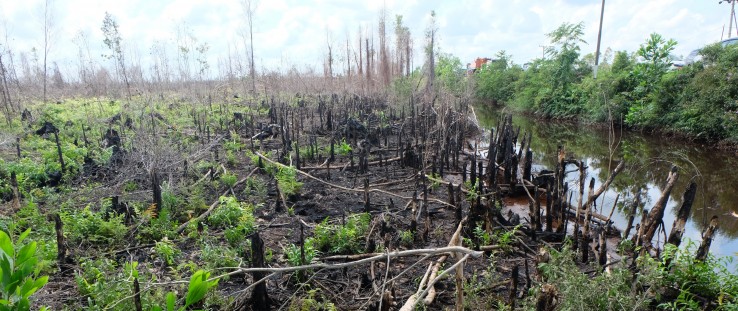 Fire destruction on peatlands
Jenna Jadin, USAID
Fire destruction on peatlands
Jenna Jadin, USAID
 Fire destruction on peatlands
Jenna Jadin, USAID
Fire destruction on peatlands
Jenna Jadin, USAID
Speeches Shim
When the most recent Indonesian dry season was at its peak in September and October 2015, smoke from peatland and forest fires cloaked large areas of Sumatra, Kalimantan and Papua in a suffocating haze that dimmed the sky to a sinister orange, closed schools and businesses, and cancelled flights throughout Southeast Asia.
The crisis was so great that the fires were a major discussion point in Indonesian President Joko “Jokowi” Widodo’s meeting with President Barack Obama in October, where Obama pledged his support to tackle the emergency. The fires intensified while Jokowi was in the United States, and he was forced to cut short his visit to return to Indonesia to coordinate the national response.
After the rains came in early November, many parts of Indonesia were left in ashes—with significant impacts to both the environment and the economy. A World Bank analysis revealed that last year’s fires cost Indonesia $16.1 billion in just five months—or twice the reconstruction costs of the 2004 Indian Ocean tsunami.
Sadly, this isn’t a stand-alone event. Fires in Indonesia occur annually—fueled by the slashing and burning of forests and peatlands primarily for the production of commodity crops such as palm oil. The 2015 burning season was exacerbated by the drier conditions caused by the El Niño weather phenomenon.
But the fires are not a result of weather alone. Widespread governance challenges contribute to the fires, from the numerous permits issued for land concessions and the lack of clarity over who has the right to clear the lands, to encroachment upon protected areas by both large corporations and small farmers.
The Role of Peat Fires in Climate Change
Peatlands are created by eons of decomposing vegetation accumulating in wet areas. They store vast quantities of carbon and can be many feet deep. Under natural conditions, peatlands absorb water in the wet season and slowly discharge water in the dry season. Large areas of tropical rainforest grow on these peatlands. This means that they regulate flooding, provide clean water, store carbon and provide habitat for endangered orangutans and other critical wildlife.
But over the last several decades, millions of acres of peatland have been drained to make them suitable for agricultural use—primarily to grow palm oil, timber, rice and other commodity crops. The draining causes the peat to dry out and decompose, which emits carbon into the atmosphere. More significantly, the drier peat is much more susceptible to fire, and large amounts of greenhouse gases are released when both the peat, and the forests growing on the peat, are burned.
The amount of greenhouse gases emitted makes Indonesia’s recurring fires an international crisis. The World Resources Institute estimates that at the height of last year’s crisis, the fires were releasing more greenhouse gas each day than the entire U.S. economy.
Providing Emergency Help During the Crisis
USAID support helped health facilities provide emergency care to those suffering from haze-related respiratory illnesses and masks to affected populations. USAID also helped with the firefighting effort.
Seven cities received 5,000 sets of protective equipment for firefighting, which included tools and fire-resistant gloves and clothes. And USAID sent four fire experts from the U.S. Forest Service to help in fire investigations to deter and prevent more fires, support firefighting management and operations, and provide needed satellite imagery.
Finally, in November, the monsoon arrived and the fires were doused—for now. But if the weather follows previous El Niño weather patterns, there is a very real possibility that they will return again this year. USAID is working to make sure that fire prevention stays on the public agenda.
“It’s a complex problem, but by addressing some of the root causes in the coming years, we hope to help Indonesia manage these valuable peatlands sustainably, to prevent this from happening again,” said Deputy Chief of Mission Brian McFeeters during his visit to inspect peatlands in January 2016.
Fire Prevention Through Improved Land Management
In 2015, USAID launched a $47 million forest management program called LESTARI, meaning “everlasting” in Indonesian. This project helps address many of the long-term causes of peatland fires by promoting better land use planning and management.
In some cases, LESTARI is helping to restore peatlands to their original condition by filling in drainage canals and letting the areas revert back to natural vegetation. But in other areas, creating alternative livelihoods is a critical part of promoting more sustainable land use. Rubber trees for example, generate income and in most cases don’t require burning the land. In fact, they provide an incentive to stop the fires.
In Central Kalimantan, Haji Alo, a farmer in Pulang Pisau, was able to save his rubber trees from the fires last year—barely.
“The fires came from everywhere, but I was able to pump water from my canal to protect my rubber trees,” he said, standing in the shade of his green plantation, pointing to the charred fields adjoining his land.
His kepala desa (village head), Yanto Adam, pointed out that farmers successfully fought the fires when they were protecting their assets. “These rubber trees are proof that our community can stop the fires when they have an incentive,” he said.
“With LESTARI, we hope to model a systematic approach to prevention and restoration. And that includes working with local farmers to improve the economic incentives for preventing fires,” said USAID/Indonesia Mission Director Andrew Sisson. “We know that the solutions need to come from working together with local communities and considering the needs of all parties.”
Learning Together
Ten years ago, in the area that is now called Sebangau National Park in Central Kalimantan, the forests were being over-harvested and the peatlands were being drained. But today, through hard work and collaboration with the Ministry of Environment and Forests, and USAID partners like World Wildlife Fund (WWF) Indonesia, the logging has stopped and the drainage canals are being re-blocked to create dams that help reintroduce water into the peat and act as buffers to prevent the spread of fires. The park is now home to 20 percent of the world’s orangutan population, and this year the fires in the park were minor compared to the fires in other areas of Central Kalimantan.
“Because we rewet the peat, you can see that the areas surrounding our dams are much greener,” said Klaas Teule of WWF Indonesia. “We see this as evidence that the dams are working.”
On the other side of the world, Indonesia’s fires and peatland devastation resonate. With support from USAID, Sebangau park officials formally signed an agreement in January to share research and technical expertise with their counterparts at the Great Dismal Swamp National Wildlife Refuge in Suffolk, Va., which also has areas of peat ranging up to 12 feet deep. It too experienced devastating fires in 2008 and 2011.
“We’ve also been rewetting some parts of Great Dismal with some success,” said Chris Lowie, who is the manager of the Virginia park and was in Indonesia earlier this year to sign the agreement. “While our parks have very different flora and fauna, we have the same challenges when it comes to hydrology. By working together, we can learn how to manage such complex ecosystems. In the U.S., we only began serious research into the soils and process in 2008 to 2009, and we’re still learning. So by studying what is happening in Kalimantan and in Sebangau National Park, it’s reaffirming that we’re doing the right thing for managing and restoring the hydrology.”
Making Sure Disaster Is Not Repeated
Speaking to reporters at the presidential palace on Jan. 19, Indonesia’s president said he expected all levels of the military and police to get involved in efforts to contain fires. He also established through presidential decree the Peat Restoration Agency, tasked with building on past efforts to prevent fires on peat as well as to restore about 2 million hectares (5 million acres) of carbon-rich peatland so they are no longer prone to fire.
“USAID looks forward to continuing our work with the Indonesian Government to prevent forest fires and support the efforts of the Peat Restoration Agency,” said USAID/Indonesia Acting Environment Office Director Heather D’Agnes. “We have a long history working together to improve natural resource management, combat climate change, and respond to disasters. We build off of our past collaboration and experience to be a more effective partner in preventing future fire crises.”
USAID's Forest Fire Prevention Activities in Indonesia
LESTARI Forestry Program: Supports conservation of more than 8 million hectares of forest in Aceh, Kalimantan and Papua by promoting transparent and accountable land use that will direct development away from fire-prone peat and primary forests, reducing the likelihood of peat fires.
U.S. Forest Service Technical Assistance: Provides experts to the Indonesian Government to help efforts to restore peatland and to use geospatial information systems for land use planning and fire prevention.
Support for Incident Command Systems: USAID’s Office of U.S. Foreign Disaster Assistance provided training to Indonesian officials in implementing incident command systems that can be a critical component of fire response.
Peat Fire Mitigation Project: Refines a recently developed tool that will help local governments identify areas prone to fire and institute an early warning system. It will also work with local stakeholders to rehabilitate damaged peatland and train local firefighters.
National Forest Policy and Advocacy Program: Advances policy reform and public advocacy to reduce deforestation and ensuing fire incidents.
Support for Smallholders: Under the Indonesian Palm Oil Pledge, a commitment by the world’s leading palm oil producers to transition to sustainable production that breaks the link with deforestation, USAID is partnering with member companies to pilot training programs to increase productivity for smallholder palm oil farmers.



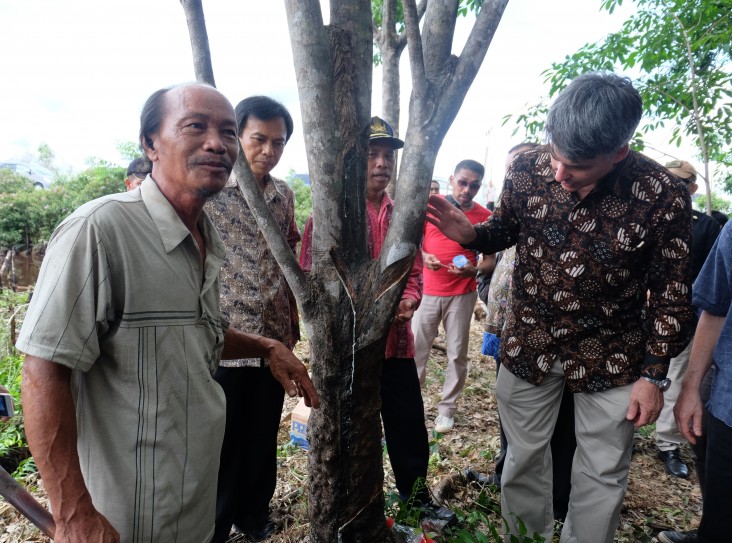
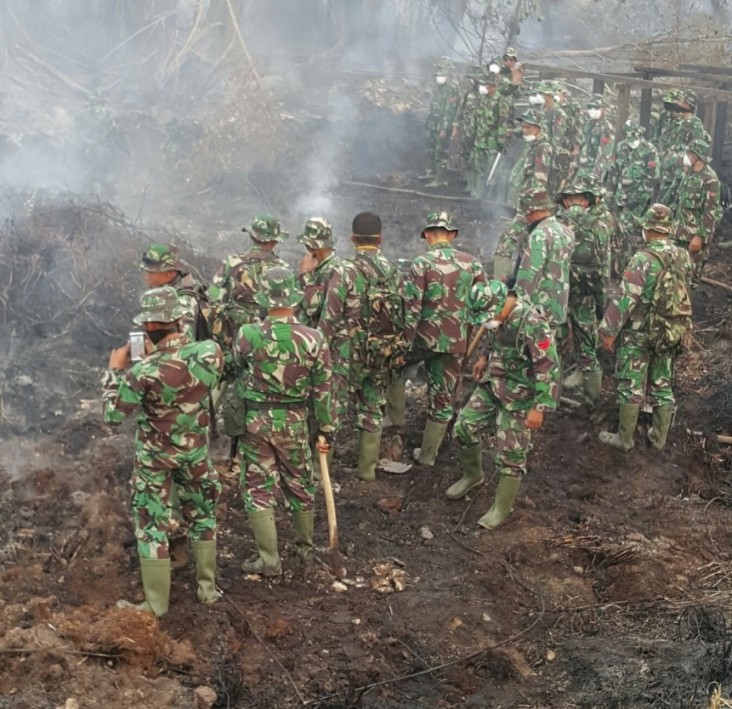
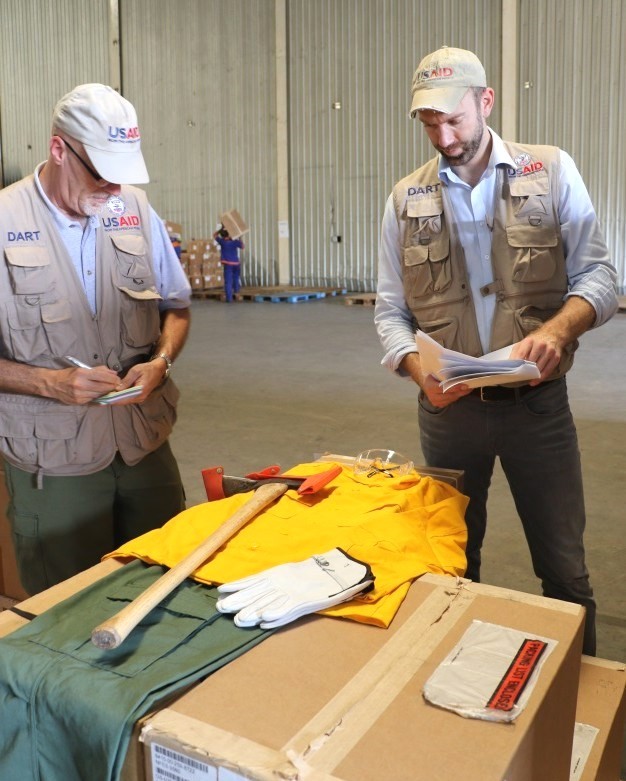
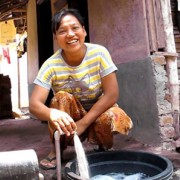
Comment
Make a general inquiry or suggest an improvement.